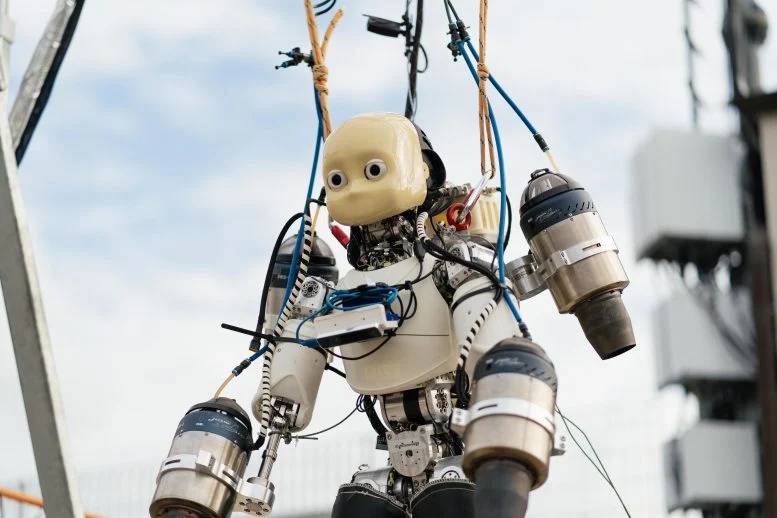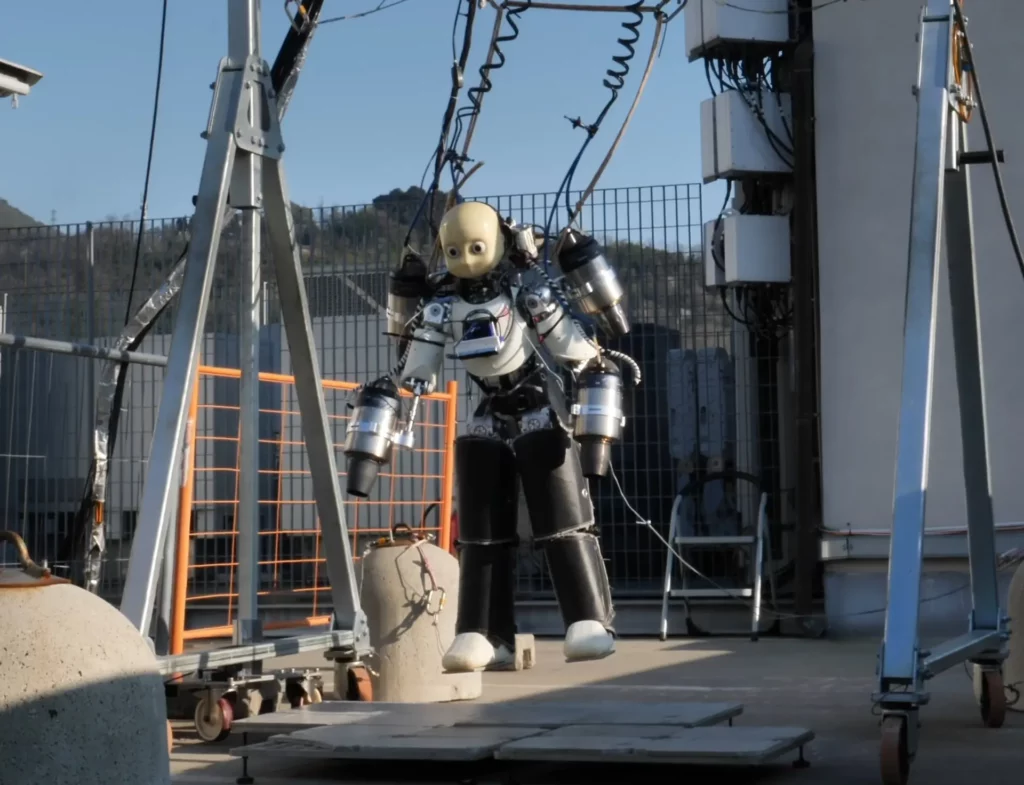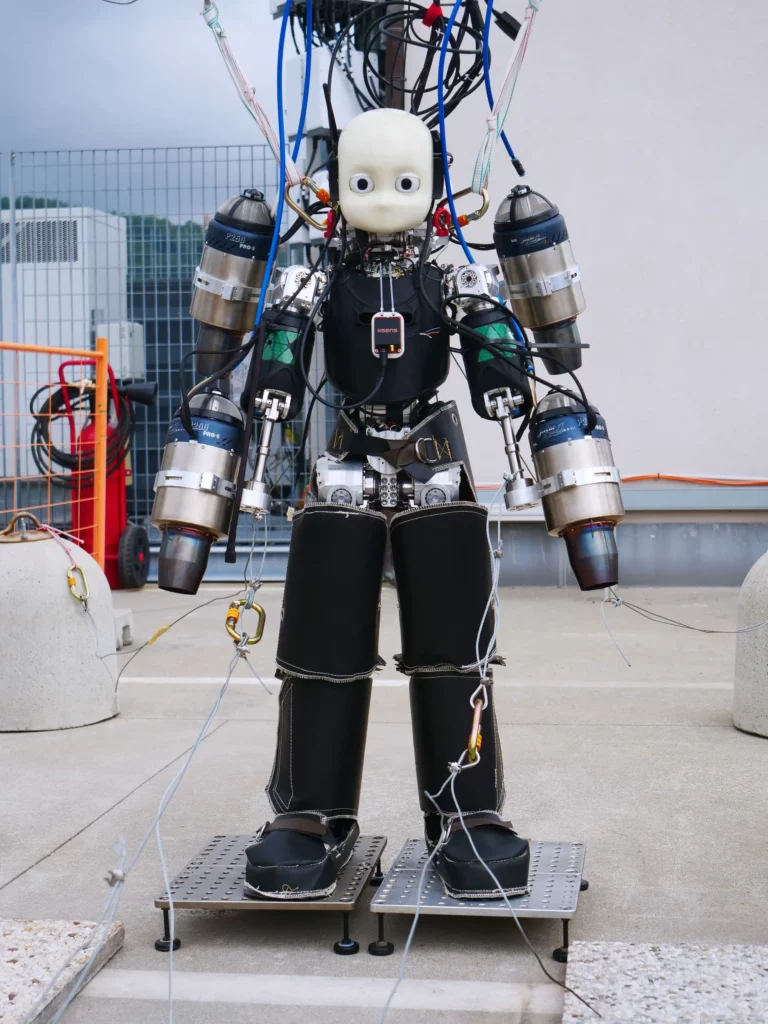
For a long time, science fiction has teased us with images of humanoid robots flying through the air like superheroes in comic books. That fantasy is getting closer to coming true now. The Italian Institute of Technology (IIT) has revealed iRonCub MK3, the first humanoid robot in the world that can take off vertically with a jetpack. This is a major step forward that could change how robots are used in disaster response, infrastructure repair, and other areas.
The robot, which is only 3 feet (1 metre) tall and weighs 49 pounds (22 kilogrammes), hovers about 20 inches (50 centimetres) off the ground in new footage. It has four thrusters: two built into its arms and two on a jetpack strapped to its back. This isn’t just a stunt; it’s a planned step towards making robots that can fly and have the same level of dexterity as people.
From Sci-Fi to Reality: The Birth of a Flying Humanoid

The iRonCub MK3 is a better version of the iCub robot, which the RobotCub Consortium built in 2009 to learn more about how AI and people think. This robot appears like a person, which is different from drones and quadcopters. It can walk, pick things up, and now it can fly.
It can go from the ground to the air and back again, which no other humanoid can do. Most robots can only walk or roll, but iRonCub’s jet thrusters enable it to do things that climbing or crawling can’t, including moving into buildings that have fallen down after an earthquake or checking the bottoms of bridges.
How Does a Robot Fly Like Iron Man?
Flying a humanoid isn’t as straightforward as just strapping on thrusters. The team had to change the robot’s skeleton so that it could handle the forces of takeoff:
- A titanium spine was placed in to support the weight of the jetpack.
- Heat-resistant plates keep the robot safe from thruster exhaust, which can become as hot as 1,112°F (600°C).
- The thrusters were aimed so that they didn’t burn the robot itself.
Engineers utilised the Finite Element Method (FEM) to see how the chassis would manage forces three times larger than the peak thrust to make sure it was sturdy enough. What went wrong? A robot that won’t break down in the sky.
The Brain Behind the Flight: A Supercomputer in the Sky
It is really hard to keep a humanoid stable in the air. Drones have set frames, while humanoids have a lot of joints that can make them unbalanced. The answer? A Linear Parameter Varying Model Predictive Control (MPC) system is a fast flight computer that keeps recalculating:
- Best thrust for the thruster
- Joint modifications to keep from flipping or going off course
The team did a lot of simulations before testing in the actual world to avoid major failures. One erroneous calculation may make the robot lose control or, even worse, catch fire.
Why Build a Flying Humanoid?
The uses go beyond just being new. The IIT team says that iRonCub could:
- Search for collapsed buildings in disasters that people or ground robots can’t get to.
- Check out dangerous places, like chemical spills or nuclear leaks.
- Fix things like the bottoms of bridges or high-voltage power lines.
A flying humanoid could clear debris, open doors, or even carry survivors, making it a possible lifesaver. Drones can’t do any of these things.
The Next Challenge: Battling Wind, Rain, and Real-World Chaos
So far, iRonCub has only flown in places where it could be controlled. What’s the next step? Making it strong enough to handle:
- Strong winds
- Rain and rough weather
- Problems that come up out of the blue
The team is making the flight controller better so it can handle these changes. If it works, future versions might have arms that can be reattached for full control in flight.
The Future: Are Flying Rescue Robots Coming Soon?

Even though iRonCub is still in the early stages of testing, its effects are huge. Imagine a time when firefighting robots fly into burning skyscrapers or disaster bots fly over the rubble left by an earthquake.
The team’s main goal right now is to keep things safe and stable. But one thing is for sure: the time of real-life Iron Man robots is no longer just a story; it’s real engineering.
Would you trust a robot that could fly to save you in an emergency? We might get the answer sooner than we think.
Sources:
- LiveScience
- Vnexpress
iRonCub3: First Liftoff of a Jet-Powered Humanoid Robot , Source: YouTube , Uploaded: Artificial and Mechanical Intelligence
The post
Watch This Humanoid Robot Fly Like Iron Man
appeared first on
Tamarafka
.









Leave a Reply